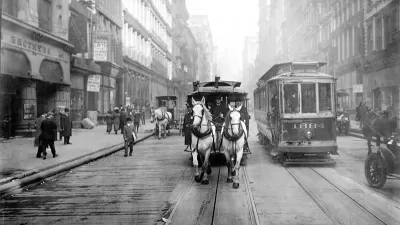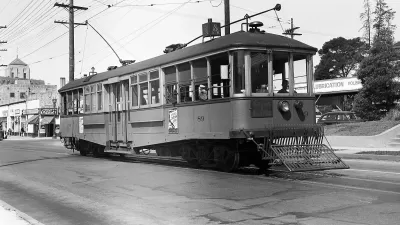In a long excerpt from his new book Seven Rules for Sustainable Communities: Design Strategies for the Post Carbon World, Patrick Condon explains the advantages of streetcars, where they went, and why we should bring them back.
Condon writes,
"Streetcar cities were walkable, transit accessible and virtually pollution free while still dramatically extending the distance citizens could cover during the day.
The planning literature occasionally refers to the streetcar city pattern, but seldom is the streetcar city mentioned for enhancing human well-being or lauded as a time when energy use per capita for transportation was a tiny fraction of what it is today.
This is tragic, because the streetcar established the form of most U.S. and Canadian cities. That pattern still constitutes the very bones of our cities -- even now, when most of the streetcars are gone."
Condon cites many studies showing the benefits of streetcars over other transportation modes.
FULL STORY: News A Tyee Series Why a Streetcar Is Something to Be Desired

Maui's Vacation Rental Debate Turns Ugly
Verbal attacks, misinformation campaigns and fistfights plague a high-stakes debate to convert thousands of vacation rentals into long-term housing.

Planetizen Federal Action Tracker
A weekly monitor of how Trump’s orders and actions are impacting planners and planning in America.

In Urban Planning, AI Prompting Could be the New Design Thinking
Creativity has long been key to great urban design. What if we see AI as our new creative partner?

King County Supportive Housing Program Offers Hope for Unhoused Residents
The county is taking a ‘Housing First’ approach that prioritizes getting people into housing, then offering wraparound supportive services.

Researchers Use AI to Get Clearer Picture of US Housing
Analysts are using artificial intelligence to supercharge their research by allowing them to comb through data faster. Though these AI tools can be error prone, they save time and housing researchers are optimistic about the future.

Making Shared Micromobility More Inclusive
Cities and shared mobility system operators can do more to include people with disabilities in planning and operations, per a new report.
Urban Design for Planners 1: Software Tools
This six-course series explores essential urban design concepts using open source software and equips planners with the tools they need to participate fully in the urban design process.
Planning for Universal Design
Learn the tools for implementing Universal Design in planning regulations.
planning NEXT
Appalachian Highlands Housing Partners
Mpact (founded as Rail~Volution)
City of Camden Redevelopment Agency
City of Astoria
City of Portland
City of Laramie




























